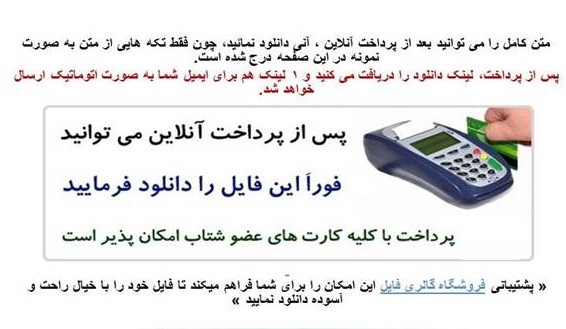لینک دانلود و خرید پایین توضیحات
فرمت فایل word و قابل ویرایش و پرینت
تعداد صفحات: 33
بورس و اهمیت ابزارهای مالی
دکتر پرویز سعیدی
چکیده
در این مقاله ابتدا به بیان مبانی بازار بورس پرداخته و سپس تلاش شده است که اهمیت ابزارهای مالی بورس در ایران بویژه نقش آنها در گسترش بازارهای پول و سرمایه، مورد بررسی قرار گیرد. در پایان پیشنهادهای اساسی ارائه شده است.
مقدمهبورس اوراق بهادار، بازار متشکل و خودانتظام است که اوراق بهادار در آن توسط کارگزاران و یا معامله گران طبق مقررات قانون بازار اوراق بهادار، مورد داد و ستد قرار می گیرد و به صورت شرکت سهامی عام تاسیس و اداره می شود.در دو دهه اخیر، پیچیدگی و تنوع ابزارهای مالی گسترش چشمگیری در اروپا، آمریکا و کشورهای خاور دور داشته، حتی پاره ای از این ابزارها در بازارهای مالی بین المللی مورد معامله قرار گرفته و بازارهای سرمایه در این ارتباط به شدت جهانی شده اند. با جهانی شدن بازارهای مالی در سراسر دنیا، واحدهای اقتصادی که در هر کشور در جستجوی سرمایه و تامین مالی می باشند، دیگر ناچار نیستند خود را به بازار داخلی محدود کنند.پیشرفتهای تکنولوژیک، یکپارچگی و کارآیی بازارهای مالی جهانی را افزایش داده است. پیشرفت وسایل و ابزارهای ارتباطی، مشارکت کنندگان دربازار را در سراسر جهان به هم می پیوندد و در نتیجه می توان سفارشها را در طول چند دقیقه به انجام رساند.پیشرفت تکنولوژی کامپیوتر، همراه با پیشرفت شبکه ارتباطات، انتقال اطلاعات لحظه به لحظه درباره بهای اوراق بهادار و دیگر اطلاعات ضروری را به سرمایه گذاران، در اغلب نقاط جهان میسر کرده است. بنابراین، بسیاری از سرمایه گذاران می توانند به بازار جهانی نظارت داشته باشند و در عین حال تجزیه و تحلیل کنند که این اطلاعات چه تاثیری بر وضع خطرساز و بازده مجموعه ابزارهای مالی آنها دارد.
تاریخچه مختصری از بورس در جهانواژه بورس از نام خانوادگی شخصی به نام وارند بورس گرفته شده که در اوایل سده پانزدهم در شهر بروژبلژیک زندگی می کرد و صرافان شهر در برابر خانه او گرد هم می آمدند و به دادو ستد کالا و پول می پرداختند. بعدها نام او به مکانهایی اطلاق شدکه محل داد و ستد پول، کالا و اسناد مالی و تجاری بوده است.نخستین مرکز بورس اوراق بهادار جهان، سال 1460 میلادی در شهر انورس کشور بلژیک تاسیس شد. اما باید توجه داشت که اگر شرکتهای سهامی متولد نمیشدند، بورس هرگز قابلیت تولد نمییافت، در این مورد باید منشأ نخستین شرکتهای سهامی را در روسیه تزاری که در سال 1553 و همچنین کمپانی هند شرقی انگلستان در سال 1602 میلادی شکل گرفتند، جستجو کنیم.
به هنگام جهش معاملات بورس و تحقق آن، دولتهای اروپایی، مانند: انگلستان، آلمان و سوئیس، قوانین و مقررات ناظر بر فعالیت این نهاد را وضع کردند. پیش از اینکه امنیت سرمایه گذاری به خطر افتد، ضمانت اجرای قانون وضع شد تا از هرگونه تقلب و تزویر و پایمال شدن حقوق صاحبان سهام جلوگیری شود.
بورس در ایرانبازار متشکل سرمایه در ایران کاملاً نو و با سرعت فوق العاده ای در حال دگرگونی و تکامل است. بازار سرمایه به معنای بازاری است که در آن تقاضای وجوه بلندمدت تامین می شود. بازار سرمایه با تاسیس بانک برنامه در سال 1325 که بعدها بانک اعتبارات صنعتی نامیده شد، بوجود آمد. بیش از آن اعتبارات بلندمدت که مقدار آن قابل توجه نبود به طور عمده از راه وامهای بانک ملی ایران تامین مالی می شد. تنظیم نخستین برنامه عمرانی هفت ساله و اجرای آن از سال 1328 لزوم ایجاد بانکهای توسعه ای و تخصصی را برای تامین منابع مالی بلندمدت نمایان ساخت. در سال 1338 بانک توسعه صنعتی و معدنی ایران با مشارکت بخش خصوصی و موسسات خارجی به عنوان نخستین بانک تخصصی تاسیس شد که هدف از ایجاد آن کمک به گسترش فعالیتهای بخش خصوصی در صنعت و معدن بود.تحولات سریع اقتصادی- اجتماعی دهه 1320 اهمیت روزافزون بازار پول و سرمایه در کشور، تدوین قوانین جامعی را که ناظر بر فعالیتهای پولی و مالی باشد، اجتناب ناپذیر ساخت. در این مورد توسعه منابع بازار پول و سرمایه بیش از همه در شبکه بانکی کشور گسترش یافت. در ارتباط با تاسیس و شکل گیری بورس اوراق بهادار تهران نخستین بار در سال 1315 شمسی وان لوتر فلد بلژیکی مطالعاتی درباره تاسیس بورس اوراق بهادار در تهران انجام داد و طرح و اساسنامه و نظامنامه داخلی آن را نیز تهیه کرد، لیکن بروز جنگ جهانی دوم در شهریور 1320 و عدم ثبات سیاسی و اقتصادی سالهای اولیه سلطنت پهلوی دوم، تاسیس بورس را در ایران به تاخیر انداخت. قوانین تجاری ایران نیز در مورد (بورس) ساکت بود و نخستین بار ضمن ماده 20 قانون تاسیس اتاق بازرگانی مصوب 7 دیماه 1333 به موضوع بورس اشاره شد و طی آن از وزارت اقتصاد خواسته شد نظرات اتاق بازرگانی را درباره مسائل مربوط به بورس، مورد توجه قرار دهد. بالاخره در اردیبهشت 1345 قانون تشکیل بورس اوراق بهادار به تصویب رسید و بوسیله وزارت

دانلود مقاله کامل درباره بورس و اهمیت ابزارهای مالی 33 ص
